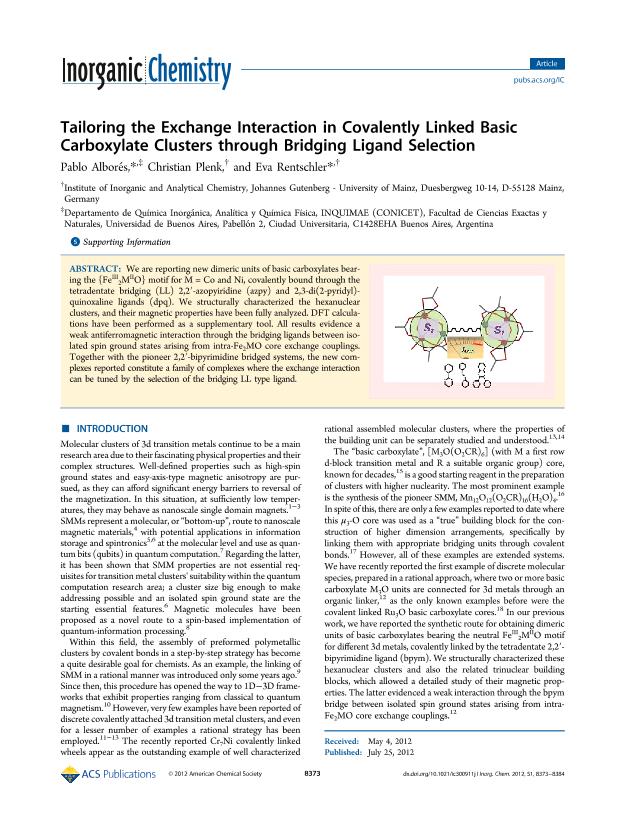Mostrar el registro sencillo del ítem
dc.contributor.author
Alborés, Pablo

dc.contributor.author
Plenk, Christian
dc.contributor.author
Rentschler, Eva
dc.date.available
2019-01-09T17:32:07Z
dc.date.issued
2012-08
dc.identifier.citation
Alborés, Pablo; Plenk, Christian; Rentschler, Eva; Tailoring the exchange interaction in covalently linked basic carboxylate clusters through bridging ligand selection; American Chemical Society; Inorganic Chemistry; 51; 15; 8-2012; 8373-8384
dc.identifier.issn
0020-1669
dc.identifier.uri
http://hdl.handle.net/11336/67771
dc.description.abstract
We are reporting new dimeric units of basic carboxylates bearing the {Fe III 2M IIO} motif for M = Co and Ni, covalently bound through the tetradentate bridging (LL) 2,2′-azopyiridine (azpy) and 2,3-di(2-pyridyl)quinoxaline ligands (dpq). We structurally characterized the hexanuclear clusters, and their magnetic properties have been fully analyzed. DFT calculations have been performed as a supplementary tool. All results evidence a weak antiferromagnetic interaction through the bridging ligands between isolated spin ground states arising from intra-Fe 2MO core exchange couplings. Together with the pioneer 2,2′-bipyrimidine bridged systems, the new complexes reported constitute a family of complexes where the exchange interaction can be tuned by the selection of the bridging LL type ligand. © 2012 American Chemical Society.
dc.format
application/pdf
dc.language.iso
eng
dc.publisher
American Chemical Society

dc.rights
info:eu-repo/semantics/openAccess
dc.rights.uri
https://creativecommons.org/licenses/by-nc-sa/2.5/ar/
dc.subject
Single-Molecule Magnets
dc.subject
Ground Spin-State
dc.subject
Pivalate Complexes
dc.subject
Quantum Information
dc.subject.classification
Otras Ciencias Químicas

dc.subject.classification
Ciencias Químicas

dc.subject.classification
CIENCIAS NATURALES Y EXACTAS

dc.title
Tailoring the exchange interaction in covalently linked basic carboxylate clusters through bridging ligand selection
dc.type
info:eu-repo/semantics/article
dc.type
info:ar-repo/semantics/artículo
dc.type
info:eu-repo/semantics/publishedVersion
dc.date.updated
2019-01-02T19:09:17Z
dc.journal.volume
51
dc.journal.number
15
dc.journal.pagination
8373-8384
dc.journal.pais
Estados Unidos

dc.journal.ciudad
Washington
dc.description.fil
Fil: Alborés, Pablo. Consejo Nacional de Investigaciones Científicas y Técnicas. Oficina de Coordinación Administrativa Ciudad Universitaria. Instituto de Química, Física de los Materiales, Medioambiente y Energía. Universidad de Buenos Aires. Facultad de Ciencias Exactas y Naturales. Instituto de Química, Física de los Materiales, Medioambiente y Energía; Argentina. Universidad de Buenos Aires. Facultad de Ciencias Exactas y Naturales. Departamento de Química Inorgánica, Analítica y Química Física; Argentina
dc.description.fil
Fil: Plenk, Christian. Johannes Gutenberg Universitat Mainz; Alemania
dc.description.fil
Fil: Rentschler, Eva. Johannes Gutenberg Universitat Mainz; Alemania
dc.journal.title
Inorganic Chemistry

dc.relation.alternativeid
info:eu-repo/semantics/altIdentifier/url/https://pubs.acs.org/doi/10.1021/ic300911j
dc.relation.alternativeid
info:eu-repo/semantics/altIdentifier/doi/https://dx.doi.org/10.1021/ic300911j
Archivos asociados
